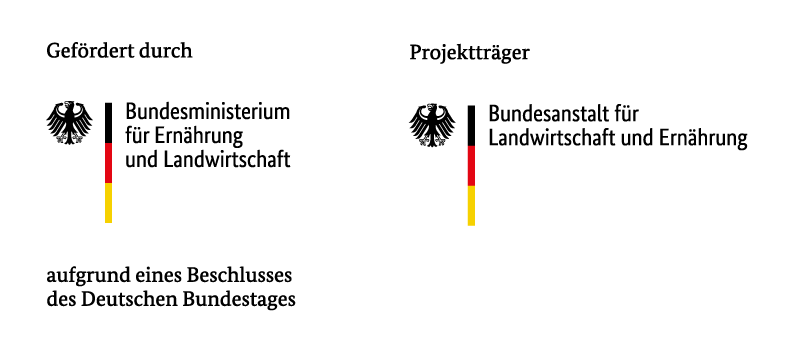
PHID Coleo II
Plant Health Identification of Coleoptera
Morphological and molecular identification of beetle species on live wood supported by new technologies: Smartphone APPs & Next-Generation-Sequencing (NGS) in the field of plant health.
Many xylobiont beetles are known by plant health authorities for their potential to become invasive and cause devastating economic and ecological damages in new habitats. Therefore, rapid detection and identification of non-native species is very important in order to prevent their successful establishment or further spread. The aim of the PHID-Coleo project series is to develop new diagnostic methods for the identification of non-native and potentially invasive beetle species discovered during plant health inspections, which could be introduced to Germany through imported wood or plant shipments.
PHID-Coleo I focused on longhorn beetles (Cerambycidae), false powderpost beetles (Bostrichidae) and true powderpost beetles (Lyctidae). During the projects runtime, a unique reference collection consisting of pinned insects, photos and gene sequences as well as literature from all over the world was compiled. In addition, dichotomous identification keys were created and molecular identification by DNA barcoding was established. Simultaneously, the University of Hohenheim, our partner in this project, conducted genome analysis of spatially separated populations of the Asian longhorn beetle (Anoplophora glabripennis). This contributed to a better understanding of the introduction and establishment of invasive wood pests.
PHID-Coleo II now extends the species spectrum to the families of jewel beetles (Buprestidae) and bark beetles (Scolytinae), which will ultimately cover all beetle families relevant to plant health on imported wood. Existing diagnostic procedures will be supported by new technologies to enable import inspectors to make on-site diagnoses and thus accelerate the initiation of protective measures. To this end, a smartphone application is being developed that can recognize selected beetles using artificial intelligence (a "beetle app") and the molecular method LAMP-PCR is being tested for its suitability to reliably identify important quarantine pests directly on-site without a laboratory, even when visual identification is no longer possible because the specimen is damaged. Additionally, metabarcoding using Next-Generation Sequencing (NGS) is being tested for its practical use in plant health. This technology makes it comparably fast and easy to identify mixed samples from trap catches on a species level and may give insights into the abundance of harmful species.
Global trade with wood and wooden package material can result in the introduction of non-native beetle species from around the world at any time. Ongoing climate change furthermore aids the establishment of invasive species and enhances their potential to cause severe economic damage. Occurrences of the Asian longhorn beetle (Anoplophora glabripennis), the citrus longhorn beetle (A. chinensis), and the redneck long horned beetle (Aromia bungii), which have resulted in the felling of numerous trees in the course of official eradication measures, are recent examples of this problem. Further cases from other countries give an outlook of what might be in store for us in the future. For example, the introduced emerald ash borer (Agrilus planipennis) has already caused millions of ash trees fatalities in North America. Moreover there is also an established population in western Russia that is increasingly spreading to Eastern Europe and has already been detected in Ukraine.
Due to the almost unmanageable amount of imported goods and the large number of species that have to be monitored, new, efficient and simple methods are needed to ensure effective and fast workflows in plant health. PHID-Coleo II aims to make a significant contribution to this.
In analogy to the PHID-Coleo I project, a comprehensive reference collection of beetle specimens from the families of jewel beetles and bark beetles will be assembled and serve as the basis for future diagnoses. These species will be used to create identification keys based on literature compiled worldwide and the knowledge of beetle experts within the project network. The expertise gained in this process, as well as photos from the reference collection, will be used in the development of the smartphone application, which will be able to identify the non-native beetle species through image recognition using artificial intelligence. This should enable plant protection service staff without extensive knowledge of entomology to obtain on-site species identification, enabling them to initiate any necessary measures or give the all clear more quickly.
Morphological diagnostic procedures using a microscope are highly dependent on the condition of the material and, to some extent, on the developmental stage of the insects. Larvae of beetles are much more difficult to identify than adults, especially since there is often hardly any reference material available and corresponding experience is required. At the same time, wood-inhabiting beetle species are particularly likely to be introduced in larval stages. Destroyed specimens, which are common in pallet wood or cut wood samples, also make diagnosis difficult to impossible. This gap can be bridged by molecular methods, but until now these have had to be carried out in the laboratory and therefore valuable time elapses before a result is available. For this reason, the LAMP-PCR method is being tested for its practical suitability. This "cold PCR" does not require a thermocycler and the result is displayed by color change, which means that the procedure can also be carried out directly at the site of discovery with little technical effort.
Another molecular method that is expected to have great potential in the future is metabarcoding. With the establishment of Next-Generation Sequencing (NGS), the process of sequencing has become automated and much faster, allowing large amounts of genetic material to be analyzed. Metabarcoding uses these sequences and compares them to biodiversity libraries such as NCBI or BOLD, making it possible to identify the mixed content of traps on a species level. In the past, individuals had to be sorted and then identified one after another by either morphology or common barcoding. Understandably, this lead to the situation where only the target species of the given monitoring program were identified. As metabarcoding is already being used by different groups and it is expected that the method will become even more widespread, the long-term goal is to connect the different groups in order to share the results. By doing this, plant health could get insights into the occurrence of potentially harmful insects in samples that were gathered e.g. during biodiversity studies in agroecology. In this project, the impacts of environmental influences, trap solutions and pollution on the analysis result will be tested and evaluated in regards to reliability. In practice, this could allow much larger sample sizes to be examined for harmful insect species and thus be identified and combatted earlier.
A strong network with different expertise is essential for achieving the project goals. In the previous project, there was already close cooperation with entomologists, molecular biologists from universities, museums and plant protection services in Germany and abroad. This network is now to be further used and expanded upon. The Zoological Diagnostic Laboratory at the LTZ Augustenberg in Karlsruhe coordinates the joint project. The scientific partner is the Department of Livestock Population Genomics of the University of Hohenheim. Samples of infested wood, beetles or larvae can be sent for free diagnostics to the address given on this website at any time. The LTZ Augustenberg is especially interested in the cooperation of private persons who would like to participate in the project by exchanging knowledge, preparations or literature. In the federal states, the respective plant protection service is responsible for the pest diagnoses . Nationwide, responsibility for plant health lies with the Julius-Kühn Institute.
The project PHID-Coleo II (funding code 2818709A19) is supported by funds from the Federal Ministry of Food and Agriculture (BMEL) based on a decision of the Parliament of the Federal Republic of Germany through the Federal Office for Agriculture and Food (BLE) under the innovation support programme.
The runtime is 3 years, during which the LTZ Augustenberg and the University of Hohenheim each employ one research associate. The subcontracts of the companies Oculyze GmbH and AIM GmbH are also fully included in this funding.






